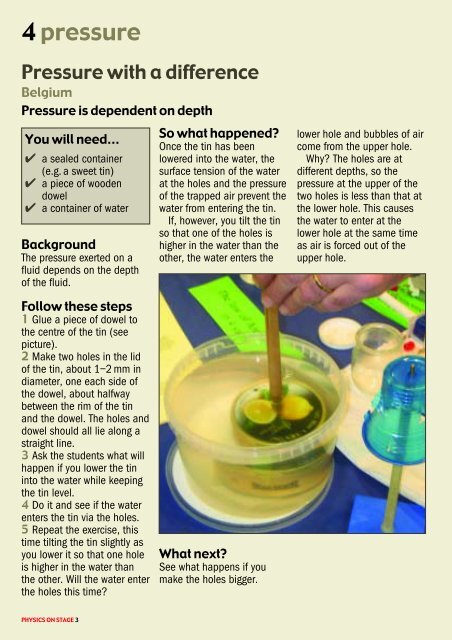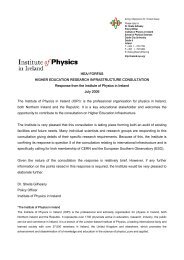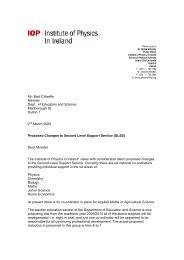PHY ICS - The Institute of Physics in Ireland
PHY ICS - The Institute of Physics in Ireland
PHY ICS - The Institute of Physics in Ireland
Create successful ePaper yourself
Turn your PDF publications into a flip-book with our unique Google optimized e-Paper software.
4 pressure<br />
Pressure with a difference<br />
Belgium<br />
Pressure is dependent on depth<br />
You will need...<br />
✔ a sealed conta<strong>in</strong>er<br />
(e.g. a sweet t<strong>in</strong>)<br />
✔ a piece <strong>of</strong> wooden<br />
dowel<br />
✔ a conta<strong>in</strong>er <strong>of</strong> water<br />
Background<br />
<strong>The</strong> pressure exerted on a<br />
fluid depends on the depth<br />
<strong>of</strong> the fluid.<br />
Follow these steps<br />
1 Glue a piece <strong>of</strong> dowel to<br />
the centre <strong>of</strong> the t<strong>in</strong> (see<br />
picture).<br />
2 Make two holes <strong>in</strong> the lid<br />
<strong>of</strong> the t<strong>in</strong>, about 1–2 mm <strong>in</strong><br />
diameter, one each side <strong>of</strong><br />
the dowel, about halfway<br />
between the rim <strong>of</strong> the t<strong>in</strong><br />
and the dowel. <strong>The</strong> holes and<br />
dowel should all lie along a<br />
straight l<strong>in</strong>e.<br />
3 Ask the students what will<br />
happen if you lower the t<strong>in</strong><br />
<strong>in</strong>to the water while keep<strong>in</strong>g<br />
the t<strong>in</strong> level.<br />
4 Do it and see if the water<br />
enters the t<strong>in</strong> via the holes.<br />
5 Repeat the exercise, this<br />
time tilt<strong>in</strong>g the t<strong>in</strong> slightly as<br />
you lower it so that one hole<br />
is higher <strong>in</strong> the water than<br />
the other. Will the water enter<br />
the holes this time?<br />
<strong>PHY</strong>S<strong>ICS</strong> ON STAGE 3<br />
So what happened?<br />
Once the t<strong>in</strong> has been<br />
lowered <strong>in</strong>to the water, the<br />
surface tension <strong>of</strong> the water<br />
at the holes and the pressure<br />
<strong>of</strong> the trapped air prevent the<br />
water from enter<strong>in</strong>g the t<strong>in</strong>.<br />
If, however, you tilt the t<strong>in</strong><br />
so that one <strong>of</strong> the holes is<br />
higher <strong>in</strong> the water than the<br />
other, the water enters the<br />
What next?<br />
See what happens if you<br />
make the holes bigger.<br />
lower hole and bubbles <strong>of</strong> air<br />
come from the upper hole.<br />
Why? <strong>The</strong> holes are at<br />
different depths, so the<br />
pressure at the upper <strong>of</strong> the<br />
two holes is less than that at<br />
the lower hole. This causes<br />
the water to enter at the<br />
lower hole at the same time<br />
as air is forced out <strong>of</strong> the<br />
upper hole.













